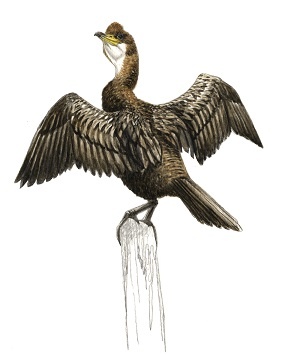Great Cormorant🠉
Phalacrocorax carbo
Large, with a long broad tail. Powerful bill. Head angular and elongated. The size and flight recall a goose, flying with the neck extended, at considerable height and often in formations, but with brief glides, a longer tail and a snaky neck. The head and tail are held rather raised in flight. On the water, swims with the body set low and the head raised. Can be confused with a diver but the Great Cormorant dives by leaping out of the water, revealing its long tail. Also the bill is held raised.
Adult: European birds are black with a metallic bluish and greenish gloss and the wings are bronzy with scaly black patterning. Bare yellow skin at the base of the lower mandible, surrounded by white. In the breeding season a white patch appears on the upper thigh and there is a sprinkling of white feathers on the top of head and on the neck. In non-breeding plumage the white on the throat and cheeks is dingier and less well-defined, and the plumage is less glossy. Adults of the subspecies lucidus and maroccanus of north-west Africa are distinguished by a noticeable contrast between the white neck, chest and upper belly and the black lower belly.
Juvenile: dark brown above and more or less whitish below, usually on the throat, chest and belly. Brown streaking on the neck and upper chest.
Voice: guttural calls at colonies and roosts.
L. 77-94 cm ; W. 121-149 cm.
Similar species: European Shag, Pygmy Cormorant.
©Thomas Galewski
European Shag🠉
Phalacrocorax aristotelis
Rather smaller and slimmer than the Great Cormorant, with a more slender neck, smaller more rounded head and finer bill. In flight, differs in the neck being held straighter, and the shorter, more rounded wings. The wingbeats are also slightly faster, with no short glides. Seen mainly at sea.
Adult breeding: black with a green gloss, and the wings are purplish-tinged with scaly black patterning. The bill is black and contrasts with the yellow gape, but the Mediterranean subspecies desmarestii has a paler, yellow bill, reducing the contrast. Has a noticeable crest.
Adult non-breeding: duller, with a shorter crest above the eye.
Juvenile: bill yellowish. Dark brown above and uniform light brown below. Small pale mark on the throat. Mediterranean birds are very pale below, almost entirely dirty white. The colour of the bill, the domed forecrown and the colouration of the chest distinguishes it from juvenile Greats Cormorants. A pale area can often be seen on the upperwing.
Voice: various growling and grunting calls.
L. 68-78 cm ; W. 95-110 cm.
Similar species: Great Cormorant, Pygmy Cormorant.
©Thomas Galewski
Pygmy Cormorant🠉
Phalacrocorax pygmaeus

The smallest cormorant, with a short, thick bill and a long tail. The neck also looks short. Blackish, glossed with dark green and bronze.
Adult breeding: white speckles on the all-brown head and on the neck and underparts.
Adult non-breeding: the chin is whitish, the chest is paler and there is no speckling.
Juvenile: duller and browner.
Voice: growls and grunts.
L. 45-55 cm ; W. 75-90 cm.
Similar species: Great Cormorant, European Shag.
©Cyril Girard (www.cyrilgirard.fr)






